Aside from the thrill of speed, what draws many riders to barrel racing is the fact that it’s a purely objective competition. You don’t need a lot of silver on your saddle, the latest show apparel or the best-bred horse. There’s no judge scrutinizing your form, and you won’t be penalized if your heels aren’t down. Or will you?
Barrel racing champion Martha Josey says it’s crucial for a barrel racer to have proper equitation, since a well-trained, finished barrel horse is extremely tuned in to his rider. “Every time we make a move they are sensitive to it, so it’s very important that we ride correctly,” she explains.
To help you improve your runs, Martha gives insider tips on the correct body position for each part of the pattern.
Moving Forward
During the speed portions of your ride—as you head away from the gate or chute, straight between barrels or home from the last barrel—your body needs to encourage your horse to go all out.
“When you want a horse to run, take some of the weight out of your seat and put it into the front of your saddle and push on your stirrups,” Martha says. Your upper body should lean slightly forward as your horse runs. Pushing on your stirrups will help you get out of the saddle without pulling on your horse’s mouth, which some riders accidentally do in an attempt to bring their upper bodies forward. “I teach to push down on (or put weight in) your stirrups and pull up on the saddle horn, not on the bridle reins. Roll your pelvis slightly forward, allowing your chin to be just in front of your saddle horn.”
A normal equitation position generally requires a straight line from your ear to your shoulder, to your hip, to your heel. “When your legs are directly under you, you’re sitting down more,” Martha says. Since you’re leaning slightly forward for the run, your legs will be a little bit behind this line. “You’re actually pushing your upper body forward with your feet and legs.”
While many people may equate western with riding one-handed, Martha recommends two hands for collection and control at high speed. “I teach riders to stay two-handed going to a barrel because it helps to line up the horse. A lot of horses need this to help keep them from moving out wide or dropping the shoulder. Also, by riding two-handed the rider is able to perform a two-hand check [if needed], which asks the horse to start his rate while staying straight.”
Your hands should be low, near your saddle horn, during the run. High hands are an all-too-common fault. “If your hands are high, and the horse has any trouble with body position, it’s hard for you to control the shoulder,” Martha says. She also finds many riders using a straight arm rather than keeping a bend in the elbow. “I see a lot of barrel racers who run with their arms straight out in front of them. I go to a barrel with an L in my elbows. Then when I do get to that turning point, my hands are ready to tilt my horse’s nose into the turn.”
The Turn
Horses tend to go where their riders are looking. Unless you want your horse to move or fade into the barrel, don’t look at it. As you approach the barrel, your eyes should look toward the pocket. “When I’m going to the right barrel first, my eyes are focusing on a spot 8 to 10 feet to the left of the barrel,” Martha explains. “How many feet you allow for will depend on the style of your horse—some horses need more of a pocket, others need less. On the second and third barrel, I look for a spot 3 to 5 feet to the right side of the barrel.”
Martha emphasizes that a finished barrel horse should automatically rate at the correct point during his approach to the barrel. If your horse doesn’t automatically rate, work on this at home by sitting deeply in the saddle when you want him to rate, putting your feet slightly forward and cueing him with your hands. “If I’ve got to help him [rate], I’d do a slight two-hand check,” she says. For additional rate practice, Martha has her students do a posting trot between the barrels and then sit around them; or she has students trot to the barrels and walk around them, sitting deep in the saddle at the rate point.
On your approach to the barrel, Martha emphasizes the order of events. “It’s rate, wait, and then turn. I want my horse to know that rate and turn mean two separate things.”
When a finished horse shifts his weight back onto his hindquarters to rate for the turn varies from horse to horse. “Some horses might be a horse length before the barrel; others will be right at the barrel. It really depends on the particular horse,” Martha says.
Your body position will change in preparation for the turn when this shift occurs (or change your position ahead of time to cue him if he’s still green and doesn’t make the shift on his own). “When my horse is starting to get on his rear end to get ready for the turn, that’s when I sit down,” Martha says. “You want the horse to be on his rear end, so you sit on your rear end deep in the saddle.” As you sit, your legs should come directly underneath you, with your heels down. “Proper position in your legs is very important in that turn,” Martha says. “A lot of times in barrel racing you get thrown forward [when you slow down for the turn], and your feet go behind you. You don’t want that to happen.” Proper leg and body position will help keep you from winding up on your horse’s neck.
Your hands will also change position as you turn. “I like to stay two-handed as long as possible,” Martha says. When it’s time to turn, however, your outside hand (the hand farthest from the barrel) will go to the saddle horn. “You should push against your horn to position your body deep in the saddle and remain sitting straight on your horse,” Martha says. The inside hand tucks the horse’s nose, by coming toward your inside hip. It’s the inside hand’s job to guide the horse, and Martha says many riders mistakenly pull toward their knee, which is too low and not the proper hand position. “When you go to your knee with your rein it causes you to lean to the inside, which is incorrect.”
Rather than leaning slightly forward as you did for the run, you will stay straight during the turn. “I always twist in my lower body, which helps my horse turn the barrel when I’m ready,” Martha says. “You’re not just sitting there looking straight ahead when that horse is turning—your body should be turning, too.” However, remember that turning your body is different than leaning, and Martha reminds riders never to lean into their turns or drop their inside shoulder. “I keep my shoulders even because dropping a shoulder here teaches the horse to shoulder into a barrel.”
Practice at Home
Martha has several recommendations for riders looking to perfect their equitation.
“A good exercise is to have the rider hang a bridle on the back of a chair and straddle a chair behind it. You can visualize going through the entire pattern practicing with hand and body position. We’ll have the students think about where to whoa and where to pull back toward the hip.”
Martha also watches all of her runs on video. “Video is one of the best tools you can have in barrel racing, and I really like to study my runs. That is why we have a professional videographer at all of our events here at the ranch. The video camera will really show you what you did correctly and what you need to work on.”
On the horse, Martha suggests practicing rollbacks without a barrel. Rollbacks help riders learn a strong, independent seat, as well as practice correct hand and leg position through a turn and takeoff.
To help your horse learn to tuck his nose around the barrel, practice teaching him to give to the bit at the standstill. “Pull back toward your hip, and the horse should stand still and bring his nose around,” Martha says. “Another way to practice correct riding is trotting and loping perfect circles on your horse. You can practice being in rhythm with your horse and having a good seat and nice quiet hands.”
Get in Shape
Another key to improving your performance is remembering that the horse isn’t the only athlete. “It’s like a good horse. He can’t win unless he’s in good shape. It’s hard for barrel racers to win unless they are in shape.”
“Playing all kinds of sports in school made
me realize how much your body helps your horse,” Martha says. “It takes
being an athlete to ride the horse right.”
Martha says barrel racers must have strong arms and strong legs.
“I do everything from jogging to push-ups,
sit-ups, and while sitting on my horse I do a variety of leg and body
flexing exercises.” In addition, she points out that, like all athletes,
barrel racers should do a lot of stretching.
Study Other Disciplines
“I study all other events,” Martha says. Like cutters, barrel racers must
be able to sit the horse, and the horse must be quick and agile around
the barrel, just as a cutting horse is to a cow. The horse also needs
speed like a racehorse, and the rider should be able to ride in a
forward position—similar to a jockey although not to the same extreme.
And like a competitive reiner, a barrel racer must have excellent hands.
Know Your Horse
Lastly,
Martha reminds riders that every horse is different, and successful
riders need to adapt their style to each horse. “I’ve been really lucky.
I’ve taken a lot of different horses to the National Finals Rodeo, and
every one of them was different. Every one of them had their own style,”
Martha says. Some horses require aggressive riding, while others run
and rate without extra pushing from the rider.
Once
you understand what your horse’s style is and learn to maintain a
proper position throughout the pattern, you will be sure to shave
seconds off your time and have more successful runs.
This article originally appeared in the December 2005 issue of Horse Illustrated magazine. Click here to subscribe!

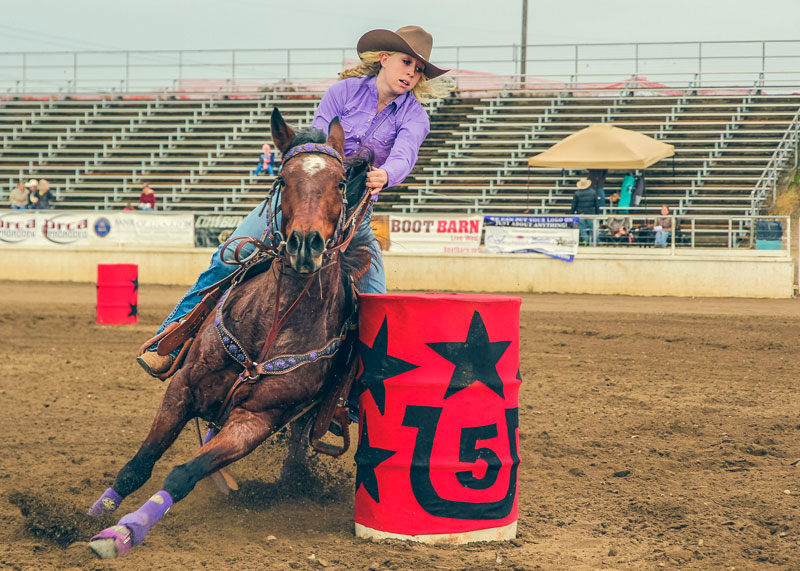
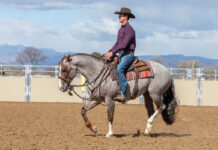
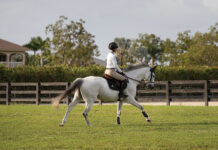
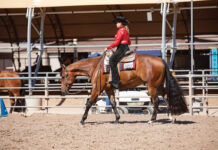
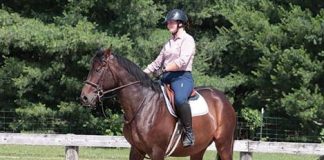

This article was really good and I learned a lot. You can never learn enough about horses and I enjoy learning more each day.
I think it will help me alot when i get my horse!!!!
riding the run is fun.its scary but fun.i love barrel racing.im am supposed to ride on december 12 at smokehouse creek rodeo arena
this will help me when i start barrel with my new horse!thnx
Thankyou Martha Josey! I always knew something didn’t feel right, so this is a great article. You can never learn enough from Martha Josey!
good article
Thank You so much Martha I am just starting Barrel Racing and I get yelled at because I’m doing something wrong and my family does video’s to and your rite it does help a whole lot thx!!!
I didn’t know there was so much to barrel racing. Great info!
Great Article alot of people don’t realize how important position of the rider is in barrel racing!
awesome article, i dont barrel race, but i want to, i have watched other girls barrel race,mabye i will someday, i will use your tips, again, awesome article,thanks for the tips.
great article, if i barrel race i will use these tips.
I used to lean forward a lot in my saddle so when i would go around a barrel i would always end up to high on my horse. These tips hepled me a lot with getting the right postioning
I’m a beginner barrel racer and you have no idea how much these tips just helped me! I am now confidenent to run home I read this like a week ago it changed my barrel racing life!:) I will run home and run to barrels with the since of I know what I am doing correctly instead of what I see on YouTube and stuff!:) I can’t have my trainer here a lot she has to work lol so this is amazing!